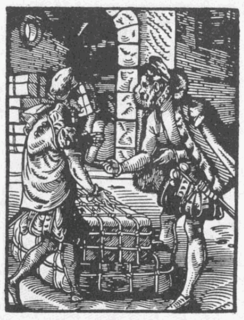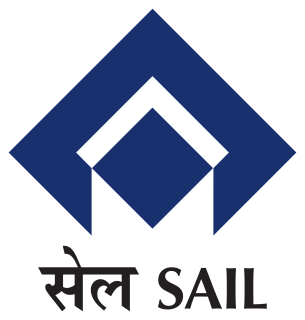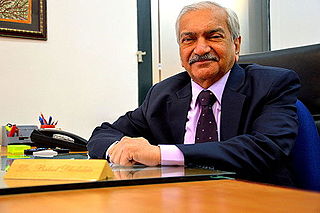Related Research Articles

Trade involves the transfer of goods or services from one person or entity to another, often in exchange for money. Economists refer to a system or network that allows trade as a market.

Steel Authority of India Limited (SAIL) is a government owned steel producer based in New Delhi, India. It is under the ownership of Ministry of Steel, Government of India with an annual turnover of INR 66,267 Crore for fiscal year 2018–19. Incorporated on 24 January 1973, SAIL has 64,628 employees. With an annual production of 16.30 million metric tons, SAIL is the 20th largest steel producer in the world and the largest in India. The Hot Metal production capacity of the company will further increase and is expected to reach a level of 50 million tonnes per annum by 2025. Smt Soma Mondal is the current Chairman of SAIL.

The economy of India is characterised as a middle income developing market economy. It is the world's sixth-largest economy by nominal GDP and the third-largest by purchasing power parity (PPP). According to the International Monetary Fund (IMF), on a per capita income basis, India ranked 145th by GDP (nominal) and 122th by GDP (PPP). From independence in 1947 until 1991, successive governments promoted protectionist economic policies, with extensive state intervention and economic regulation. This is characterised as dirigism, in the form of the License Raj. The end of the Cold War and an acute balance of payments crisis in 1991 led to the adoption of a broad economic liberalisation in India. Since the start of the 21st century, annual average GDP growth has been 6% to 7%, and from 2013 to 2018, India was the world's fastest growing major economy, surpassing China. Historically, India was the largest economy in the world for most of the two millennia from the 1st until the 19th century.
'India' was the one of the largest economies in the world for most of the next two and a half millennia, starting around the end of 1st millennium BCE and ending around the beginning of British rule in India.

Muscovado is a type of partially refined to unrefined sugar with a strong molasses content and flavour, and dark brown in colour. It is technically considered either a non-centrifugal cane sugar or a centrifuged, partially refined sugar according to the process used by the manufacturer. Muscovado contains higher levels of various minerals than processed white sugar, and is considered by some to be healthier. Its main uses are in food and confectionery, and the manufacture of rum and other forms of alcohol. The largest producer and consumer of muscovado is India.
The history of agriculture in India dates back to the Indus Valley Civilization. India ranks second worldwide in farm outputs. As per 2018, agriculture employed more than 50% of the Indian work force and contributed 17–18% to country's GDP.

The National Petrochemical Company (NPC), a subsidiary to the Iranian Petroleum Ministry, is owned by the government of the Islamic Republic of Iran. It is responsible for the development and operation of the country's petrochemical sector. Founded in 1964, NPC began its activities by operating a small fertilizer plant in Shiraz. Today, NPC is the second largest producer and exporter of petrochemicals in the Middle East. Over these years, it has not only expanded the range and volume of its products, but it has also taken steps in areas such as R&D to achieve more self-sufficiency.

Roughly one-third of Iran's total surface area is suited for farmland, but because of poor soil and lack of adequate water distribution in many areas, most of it is not under cultivation. Only 12% of the total land area is under cultivation but less than one-third of the cultivated area is irrigated; the rest is devoted to dryland farming. Some 92 percent of agricultural products depend on water. The western and northwestern portions of the country have the most fertile soils. Iran's food security index stands at around 96 percent.

The economy of Uttar Pradesh is the third largest of all the states of India. According to a report published by the Ministry of Statistics and Programme Implementation, Government of India the nominal GDP of the state for the year 2020-21 is ₹ 17.05 lakh crore. The largest Indian state, Maharashtra based on nominal GDP, has an urban population of 5,08,18,259, while Uttar Pradesh has an urban population of 4,44,95,063. According to the 2011 census report, 22.76% of Uttar Pradesh's population lives in urban areas. The state has 7 cities with populations exceeding 10 lakh each. After partition in 2000, the new Uttar Pradesh state produces about 92% of the economic output of the old Uttar Pradesh state. Currently, the poverty rate stands at 26.4%, just above the national average.

The economy of Maharashtra is the largest in India. It is one of the most urbanised of Indian States.

The economy of Punjab is the 16th largest state economy in India with ₹5.29 lakh crore (US$74 billion) (FY2020-21) in gross domestic product and a per capita GDP of US$2,090, ranking 19th amongst Indian states. Punjab ranked first in GDP per capita amongst Indian states in 1981 and fourth in 2001, but has experienced slower growth than the rest of India in recent years, having the second-slowest GDP per capita growth rate of all Indian states and UTs between 2000 and 2010, behind only Manipur. The state's economy is mainly dominated by agricultural production and small and medium-sized enterprises. Punjab has the ninth highest ranking among Indian states and union territories in human development index as of 2018.

The Economy of Assam is largely agriculture based with 69% of the population engaged in it.

Economy of Bihar is largely agriculture-based, but it also has a significant service-orientation.

The economy of Odisha is one of the fastest growing economy in India. According to 2014-15 economic survey, Odisha's gross state domestic product (GSDP) was expected to grow at 8.78%. Odisha has an agriculture-based economy which is in transition towards an industry and service-based economy. According to recent estimates, the size of Odisha's economy has increased by 122.27 per cent during the last six years in terms of the gross state domestic product (GSDP). Thereby, Odisha achieved an annual average growth rate of 6.23 per cent during that period. Odisha is also one of the top FDI destinations in India. In the fiscal year 2011–12, Odisha received investment proposals worth ₹49,527 crore. According to the Reserve Bank of India, It received ₹53,000 crore worth of new FDI commitments in the 2012-13 fiscal year.

Uttarakhand's gross state domestic product for 2004 is estimated at $6 billion in current prices. Born out of partition of Uttar Pradesh, the new state of Uttarakhand produces about 8% of the output of the old Uttar Pradesh state.

Bakul Harshadrai Dholakia is the former Director of IIM Ahmedabad (2002–2007). Prior to that, he was the Dean at Ahmedabad (1998–2001) and a professor in Economics He was also the Director General of International Management Institute, New Delhi. Prior to joining IMI New Delhi, he was the Director of Adani Institute of Infrastructure Management and Gujarat Adani Institute of Medical Sciences, Bhuj.

MMTC Ltd., Metals and Minerals Trading Corporation of India, is one of the two highest earners of foreign exchange for India and India's largest public sector trading body. Not only handling the export and import of primary products such as coal, iron ore, agro and industrial products, MMTC also exports and imports important commodities such as ferrous and nonferrous metals for industry, and agricultural fertilizers. MMTC's diverse trade activities cover Third Country Trade, Joint Ventures and Link Deals and all modern forms of international trading. The company has a vast international trade network, spanning almost in all countries in Asia, Europe, Africa, Oceania, America and also includes a wholly owned international subsidiary in Singapore, MTPL. It is one of the Miniratnas companies.
Kakira Sugar Works Limited, often referred to as Kakira Sugar Works (KSW), is a leading sugar manufacturer in Uganda, the third-largest economy in the East African Community.

Sugar has been produced in India since ancient times and then it spread to other parts of the world. Sugarcane is a native of tropical Indian subcontinent and Southeast Asia. In India, sugarcane is planted thrice a year in October, March and July depending on part of the country. Most of the sugar production in India takes at local Cooperative Sugar mills. After gaining Independence, India made serious plans for overall industrial development of sugar industry.
Manufacturing in Sudan remains a relatively small sector of the economy, accounting for 11.75% of GDP as of 2019 according to the World Bank. Manufacturing in Sudan has a long history, with many forms of industry being attempted since World War II. Growth has been more consistent in the 21st century than previously.
References
- ↑ Bhosale, Jayashree (2019-01-21). "ISMA cuts India's 2018-19 sugar production estimate to 307 lakh tonnes". The Economic Times. Retrieved 2019-06-03.
- ↑ Mukherjee, Ritwik (2019-06-03). "Sugar dearer on cane availability concerns". The Asian Age. Retrieved 2019-06-03.
- ↑ "Sugar mills in Meerut on the verge of shutting down". Economic Times. 24 April 2012. Retrieved 24 April 2012.
- ↑ "Sugar traders' body AISTA seeks duty-free imports". @businessline. Retrieved 2019-06-03.
- ↑ "Sugar output up 13% of October–March - Indian Sugar Mills Association". Economic Times. Apr 3, 2012. Retrieved 24 April 2012.
- ↑ "India could soon become the world's largest sugar producer but here's why that's a problem". Business Insider. Retrieved 2019-06-03.
- ↑ "India's 2018-19 sugar output likely to hit new record 35.5 million tonnes". The Times of India. Retrieved 2019-06-03.